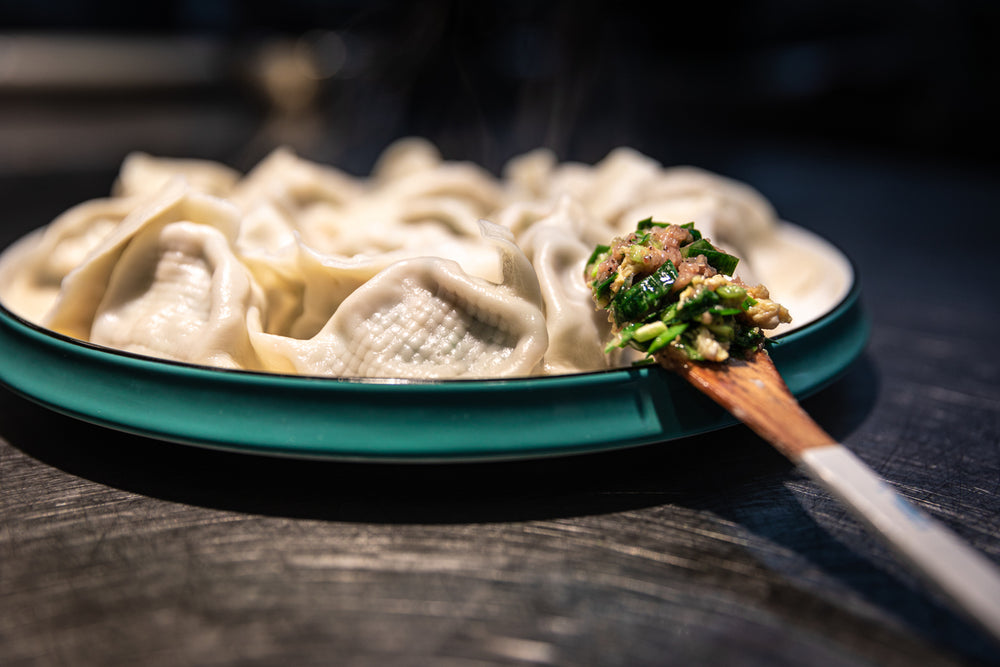Dumplings are steamed wrappers filled with meat, vegetables of eggs that are tiny bursts of flavour. They are easy to cook and are comforting to eat. One can enjoy dumplings anytime during the day, for any meal. They are popular across the world and people fill the wrappers with a variety of preparations (according to the region they live in) and enjoy them with different condiments.
Origin of Dumplings
The origin of dumplings goes back to China 206 BC-220 AD when the Han Dynasty was in power. Back then they were known as jiozi and were prepared by wrapping ground meat and vegetables in a thin layer of dough. Like modern-day dumplings, Jiozi too was either steamed or boiled. People served jiozi only in special occasions as they were considered a symbol of wealth.
Over time, jiozi became dumplings and are said to have been invented between 150 and 219 AD by Zhang Zhongjing in Neiyang, China when he asked the people of his town to serve a bowl of broth along with two meatballs enclosed in dough shaped like ears, to their family members. He gave these instructions when people of his town were losing their ears to frostbite during the winter. They thought that it would increase blood flow to their ears.
Fame of dumplings soon spread to countries far and wide after the Silk Route was opened and trade flourished between Asia and Europe. The Europeans filled dough wrappers with meat and consumed as a meal while the Americans stuffed it with sweet potatoes and corn.
Some Famous Versions of Dumplings
They may be known differently in different parts of the world and they may have a variety of fillings but they taste wonderful and are easy to make too. Here are some famous types of dumplings from across the world:
Jiaozi from China: The Classic Boiled Dumpling

Jiaozi are traditional Chinese dumplings typically filled with a savoury mixture of ground pork or beef, cabbage and green onions and seasoned with ginger and soy sauce. These dumplings are boiled until tender and are often served with a dipping sauce made from soy sauce, vinegar, and chili oil. Jiaozi are especially significant during the Lunar New Year, symbolizing wealth and good fortune.
Momos from Nepal and Tibet: A Steamed Treat
Momos are popular in Nepal and Tibet, featuring fillings like minced chicken or buffalo meat mixed with onions, garlic, ginger, and spices. Vegetarian versions might include cabbage, carrots and tofu. These dumplings are steamed and typically served with a spicy tomato-based dipping sauce called achar. Momos are enjoyed as street food and are a beloved part of family meals in these regions.
Pierogi from Poland: A Boiled Delight
Pierogi are a beloved Polish dumpling that can be filled with a variety of ingredients, such as mashed potatoes, cheese, sauerkraut, or minced meat. These dumplings are boiled until they float and can be served with toppings like melted butter, sour cream, or fried onions. Pierogi are a staple in Polish cuisine and are often enjoyed during festive occasions, especially Christmas Eve.
Mandu from Korea: A Steamed Favourite
Mandu are Korean dumplings that can be filled with a mix of minced pork or beef, tofu, vegetables, and glass noodles. These dumplings are steamed and served with a dipping sauce made from soy sauce, vinegar, and sesame oil. Mandu are commonly eaten during Korean New Year celebrations and are enjoyed for their delicate flavour and satisfying texture.
Gyoza from Japan: A Steamed or Pan-Fried Classic
Gyoza are Japanese dumplings inspired by Chinese Jiaozi but often have a thinner skin and a more finely chopped filling. The filling typically consists of ground pork or chicken mixed with cabbage, garlic, ginger, and green onions. Gyoza can be either steamed or lightly pan-fried before steaming, giving them a crispy bottom. They are usually served with a dipping sauce made from soy sauce, rice vinegar, and chili oil. Gyoza are a popular side dish in Japan, enjoyed with ramen or on their own as a snack.
Chuchvara from Uzbekistan: A Boiled Dumpling Treat
Chuchvara are traditional Uzbek dumplings that are small and typically filled with minced lamb or beef mixed with onions and seasoned with salt and pepper. These dumplings are boiled and often served in a flavourful broth or with a dollop of sour cream. Chuchvara are a comforting dish in Uzbek cuisine and are enjoyed during family meals, especially in colder seasons.
Manti: A Flavourful Classic
Manti are small, steamed dumplings popular in countries like Turkey, Uzbekistan, and Armenia. They are filled with minced lamb or beef, onions, and various spices. The dumplings are often steamed and served with yogurt and a sauce made from garlic, paprika and butter. In Uzbekistan, manti are sometimes filled with pumpkin and are a staple of local cuisine.
Pelmeni: Steamed Treat Packed with Flavours
Pelmeni are Russian dumplings usually filled with minced meat such as pork, beef, or lamb, along with onions and garlic. The dough is thin and the dumplings are small, making them quick to cook in boiling water. Pelmeni are often served with butter, sour cream, or vinegar and are a popular comfort food in Russian cuisine.
Buuz: Steamed Delicacy
Buuz are Mongolian steamed dumplings traditionally filled with minced mutton or beef, mixed with onions, garlic and sometimes cabbage. The dough is thicker than other dumplings, creating a hearty meal. Buuz are steamed and are especially popular during the Lunar New Year celebrations.
Considering the growing popularity and love for dumplings, companies developed convenient solutions to meet this demand. Dumpling mixes, like Green Dumpling Mix, make it easy to prepare delicious homemade dumplings. These mixes provide a simple recipe and quality ingredients, allowing anyone to create flavourful dumplings quickly. A premix such as this has made it easy to prepare authentic dumplings at home and enjoy it with friends and family.


 Christmas 2025
Christmas 2025
 Frozen Food
Frozen Food
 Baking
Baking
 Beans, Peas, Soups & Tins
Beans, Peas, Soups & Tins
 Biscuits, Crackers & Cookies
Biscuits, Crackers & Cookies
 Candy / Sweets
Candy / Sweets
 Crisps & Snacks
Crisps & Snacks
 Chemist / Pharmacy
Chemist / Pharmacy
 Desserts
Desserts
 Gravy, Stock & Paste
Gravy, Stock & Paste
 Haggis
Haggis
 Indian Sauces, Paste and Pickle
Indian Sauces, Paste and Pickle
 Jams & Preserves
Jams & Preserves
 Poppy Appeal
Poppy Appeal
 Pot Noodles & Super Noodles
Pot Noodles & Super Noodles
 Scone Mix
Scone Mix
 Gluten-Free / Free From
Gluten-Free / Free From
 Tea Accessories
Tea Accessories
 Teapot & Tea sets
Teapot & Tea sets
 Tea For One
Tea For One
 Sugar & Creamer
Sugar & Creamer
 Tableware
Tableware
 Serveware
Serveware
 Plates & Trays
Plates & Trays
 Bowls
Bowls
 Cups & Saucers
Cups & Saucers
 Mugs
Mugs
 Silverware
Silverware
 Dinnerware - Accessories
Dinnerware - Accessories
 Dinnerware - For Pets
Dinnerware - For Pets
 Victoria Eggs - Hand-Drawn UK Homeware
Victoria Eggs - Hand-Drawn UK Homeware
 Jewelry & Accessories
Jewelry & Accessories
 Sale
Sale
 Christmas Gifts
Christmas Gifts

